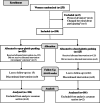Does the type of pushing at delivery influence pelvic floor function at 2 months postpartum? A pragmatic randomized trial-The EOLE study
- PMID: 36352788
- PMCID: PMC9780713
- DOI: 10.1111/aogs.14461
Does the type of pushing at delivery influence pelvic floor function at 2 months postpartum? A pragmatic randomized trial-The EOLE study
Abstract
Introduction: Maternal pushing techniques during the second stage of labor may affect women's pelvic floor function. Our main objective was to assess the impact of the type of pushing used at delivery on the mother's medium-term pelvic floor function.
Material and methods: This is a secondary analysis of a randomized clinical trial (clinicaltrials.gov: NCT02474745) that took place in four French hospitals from 2015 through 2017 (n = 250). Women in labor with a singleton fetus in cephalic presentation at term who had undergone standardized training in both of these types of pushing were randomized after cervical dilation ≥7 cm. The exclusion criteria were a previous cesarean, a cesarean delivery in this pregnancy or a fetal heart rate anomaly. In the intervention group, open-glottis (OG) pushing was defined as a prolonged exhalation contracting the abdominal muscles to help move the fetus down the birth canal. Closed-glottis (CG) pushing was defined as Valsalva pushing. The principal outcome was the stage of pelvic organ prolapse (POP) assessed by the Pelvic Organ Prolapse-Quantification 2 months after delivery. A secondary outcome was incidence of urinary incontinence (UI). The results of our multivariable, modified intention-to-treat analysis are reported as crude relative risks (RRs) with their 95% confidence intervals.
Results: Our analysis included 207 women. Mode of birth was similar in both groups. The two groups did not differ for stage II POP: 10 of 104 (9.4%) in the OG group compared with 7 of 98 (7.1%) in the CG group, for a RR 1.32, 95% confidence interval [CI] 0.52-3.33, and an adjusted RR of 1.22, 95% CI 0.42-3.6. Similarly, the incidence of UI did not differ: 26.7% in the OG group and 28.6% in the CG group (aRR 0.81, 95% CI 0.42-1.53). Subgroup analysis suggests that for secundiparous and multiparous women, OG pushing could have a protective effect on the occurrence of UI (RR 0.33, 95% CI 0.13-0.80).
Conclusions: The type of directed pushing used at delivery did not impact the occurrence of pelvic organ prolapse 2 months after delivery. OG pushing may have a protective effect against UI among secundiparous and multiparous women.
Keywords: Valsalva pushing, closed glottis pushing; delivery; directed pushing; open glottis pushing; pelvic floor; pelvic organ prolapse; urinary incontinence.
© 2022 The Authors. Acta Obstetricia et Gynecologica Scandinavica published by John Wiley & Sons Ltd on behalf of Nordic Federation of Societies of Obstetrics and Gynecology (NFOG).
Conflict of interest statement
The authors have stated explicitly that there are no conflicts of interest in connection with this article.
Figures

Similar articles
-
Is directed open-glottis pushing more effective than directed closed-glottis pushing during the second stage of labor? A pragmatic randomized trial - the EOLE study.Midwifery. 2020 Dec;91:102843. doi: 10.1016/j.midw.2020.102843. Epub 2020 Sep 22. Midwifery. 2020. PMID: 32992159 Clinical Trial.
-
Effect of the type of maternal pushing during the second stage of labour on obstetric and neonatal outcome: a multicentre randomised trial-the EOLE study protocol.BMJ Open. 2016 Dec 20;6(12):e012290. doi: 10.1136/bmjopen-2016-012290. BMJ Open. 2016. PMID: 27998899 Free PMC article. Clinical Trial.
-
Pelvic floor muscle strength and the incidence of pelvic floor disorders after vaginal and cesarean delivery.Am J Obstet Gynecol. 2020 Jan;222(1):62.e1-62.e8. doi: 10.1016/j.ajog.2019.08.003. Epub 2019 Aug 8. Am J Obstet Gynecol. 2020. PMID: 31422064
-
Influence of pregnancy and mode of delivery on pelvic floor function: a review of literature.Ginekol Pol. 2024;95(10):830-834. doi: 10.5603/gpl.98418. Epub 2024 May 8. Ginekol Pol. 2024. PMID: 38717218 Review.
-
Seeking the Truth About Primary Elective Cesarean Delivery and Pelvic Floor Disorders: A Systematic Review and Meta-Analysis.Female Pelvic Med Reconstr Surg. 2022 Mar 1;28(3):e108-e114. doi: 10.1097/SPV.0000000000001164. Female Pelvic Med Reconstr Surg. 2022. PMID: 35272343
Cited by
-
Effects of manual perineal protection and pushing techniques used in the second stage of labor on perineal outcomes: a randomized controlled trial of combinations of strategies.BMC Pregnancy Childbirth. 2025 Jun 19;25(1):671. doi: 10.1186/s12884-025-07564-6. BMC Pregnancy Childbirth. 2025. PMID: 40537769 Free PMC article. Clinical Trial.
-
Pressure-Mediated Biofeedback With Pelvic Floor Muscle Training for Urinary Incontinence: A Randomized Clinical Trial.JAMA Netw Open. 2024 Nov 4;7(11):e2442925. doi: 10.1001/jamanetworkopen.2024.42925. JAMA Netw Open. 2024. PMID: 39499517 Free PMC article. Clinical Trial.
References
-
- Abrams P, Smith AP, Cotterill N. The impact of urinary incontinence on health‐related quality of life (HRQoL) in a real‐world population of women aged 45–60 years: results from a survey in France, Germany, the UK and the USA. BJU Int. 2015;115:143‐152. - PubMed
-
- Wood LN, Anger JT. Urinary incontinence in women. BMJ. 2014;349:g4531. - PubMed
-
- Vrijens D, Berghmans B, Nieman F, van Os J, van Koeveringe G, Leue C. Prevalence of anxiety and depressive symptoms and their association with pelvic floor dysfunctions—a cross sectional cohort study at a pelvic care Centre. Neurourol Urodyn. 2017;36:1816‐1823. - PubMed
-
- Leng B, Zhou Y, Du S, et al. Association between delivery mode and pelvic organ prolapse: a meta‐analysis of observational studies. Eur J Obstet Gynecol Reprod Biol. 2019;235:19‐25. - PubMed
Publication types
MeSH terms
Associated data
Grants and funding
LinkOut - more resources
Full Text Sources
Medical
Miscellaneous

